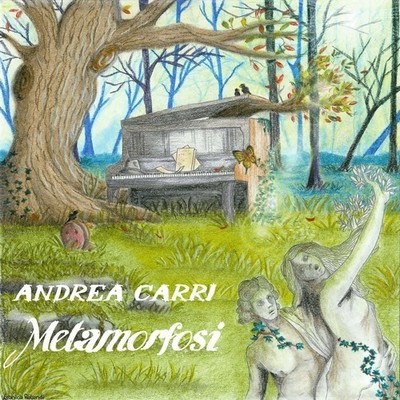Andrea Carri
“Metamorfosi”

Andrea Carri was among the first pianists I met on SoundCloud. Though just 24 years old, Andrea has released four full albums as well as a few singles. He has performed solo and with different bands. Even more impressively, his compositions have appeared on TV and in short films.
Andrea’s love for piano has started since the age of six, when, “instead of giving him Lego” (c), his parents gave him his first “Bontempi” keyboard. As Andrea says on his site, “playing live is a fresh air for my lungs, vital and indispensable”.
A year ago I came across Andrea’s third album, which is called “Metamorfosi” (released in 2013), and I was captivated by its delicate and spacious melodies, as pure as raindrops. Andrea started working on the album during the late Autumn - the season that he has been always fascinated by. It’s a season of music, if one would exist…
The harmonies of the first few tracks are structured, but leave space for variation, with twists from major to minor, and sometimes for semi-tonal shifts in the melodic line. The dynamic subtleties are especially enjoyable, while the melodies remain bare and minimal.
While listening to “Giochi di luce” (“Games of light”), the third track of the album, I was strongly reminded of one of my favourite composers - Debussy. His “Reverie” has such an angelic melody, very sensitive and rich rhythmically, with both hands leading and intertwining. "Giochi di luce" is reminiscent of this and is my personal favourite here. To use an artistic metaphor, I would illustrate this particular tune in water colours and Chinese motifs. Hearing those pentatonic scales on many tracks of this album, I wonder if it was a deliberate choice, influence, or merely a coincidence.
Next up, “Frammenti”, combines lovely switches in tempo and moods: from meditative, cautious minor to speeding up major parts around the middle of the track. I can’t help but admire the accentuation of various parts in the melody: some parts are syncopated while others are more predictable in their rhythm. Lovely variations on the main theme appear, and are memorable and haunting. This is one of those pieces that I immediately want to play by ear, or search for the score. True to its name, “Fragments” is rather like a puzzle of glass pieces, combining in variations, and sealed with repetitive harmonies.
“Metamorfosi”, the title track, is a minimalistic delicate tune, which allows you to enjoy the deeper reverberation and the brightness of the piano in both high and low registers. A true masterpiece, I would say.
The following “Riflessi d’autunno” (“Reflections of Autumn”), as the title suggests, includes somewhat impressionistic touch on the keys. Short splashes of notes are followed by the flowing melody, which is very cinematic. Particularly impressive to me is the fact that the composer followed his own concept of natural sounds and the metamorphosis is continuously happening from one track to another. It sounds as a whole spectrum of one main theme; life in its fullness: harmonious but not monotonous.
“Sunshine after rain” is surprisingly described by lower sounds than the previous tracks. And how beautiful and gracious the melody becomes, when switching to higher register! It is followed by “Cuori nei vento”, which is more intimate, with a lighter reverb, sounding to me as being slightly shaded. This track is the essence of the delicacy that projects over this album time and again.
The following track, “Moments of life”, has a particularly memorable melody, stepping slowly through the shadows and special effects in the lower register of the piano, which some of the previous tracks had explored. A lot of tension is created through repetition here. The second part of the piece contrasts, using more spacious octaves at the beginning of the new theme. Such music makes a perfect fit for those like me, who can’t study without good music to put their mind at ease and focus the attention!
“Memoria” (“Memory”), the tenth track, has a lovely New Age, modern feel with profound inner rhythm that is not obvious, yet surely there. No drum beats or percussion were needed - simply the richness of the piano and well crafted composing. The track has a lovely ending, with the piano fading away to leave space for whispering voices.
“Fluire” (“Flow”) includes a lovely dialogue between high and low registers, taking turns to lead, followed by massive chords culminating in waves of melodies in both hands.
“Diario di un viaggiatore” (“Diary of a traveller”) has a surprisingly fast, almost rushing intro with a melodic line that was intertwined in some previous tracks as a motif, when each note is just a step away from another, gentle but intense. It was a great pleasure to witness a wide dynamic range of the pianist - even a repetitive melody becomes fully live and intriguing. At around three minutes into the track the upper melody is especially clear without the intense rhythmic support in the bass register.
I loved how each track of this album is naturally transformed into the following one. The concluding “Passeggiata alla ricerca di me stesso” (“Searching for myself”) is no exception. Some surprises in timing and many tempo variations make this track so breathable. Every phrase here is a sensual delivery of joy in music, joy in nature, a never-ending metamorphosis.
In my opinion, describing such an album would be as hard as categorizing the beauty itself. Trying to fit it into a “box” is as hopeless as trying to hold a fragile miniature with thick gloves.
- “Metamorfosi” on BandCamp
- Andrea Carri’s official site.
- Andrea Carri on Facebook
- Andrea Carri on SoundCloud
Album review by Milana Zilnik
Proof-reading by Arty Sandler